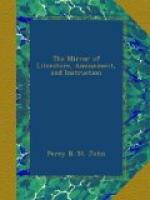Mr. H. then enumerates the principle of the improvements:—“That troublesome appendage the fly-wheel, as I have observed, Mr. Gurney has rendered unnecessary. The danger to be apprehended in going over rough pitching, from too rapid a generation of steam, he avoids by a curious application of springs; and should these be insufficient, one or two safety valves afford the ultimatum of security. He ensures an easy descent down the steepest declivity by his ‘shoe-drags,’ and the power of reversing the action of the engines. His hands direct, and his foot literally pinches obedience to the course over the roughest and most refractory ground. The dreadful consequences of boiler-bursting are annihilated by a judicious application of tubular boilers. Should, indeed, a tube burst, a hiss about equal to that of a hot nail plunged into water, contains the sum total of alarm, while a few strokes with a hammer will set all to rights again. Lastly, he has so contrived his ‘carriers,’ that they shall act without confining the wheels, by which means there is none of that sliding and consequent cutting up of the road, which, in sharp turnings, would result from inflexible constraint.
“Hills and loose, slippery ground are well known to be the res adversae of steam-carriages; on ordinary level roads they roll along with rapid facility. In every ascent there are two additional circumstances inimical to progressive motion. One is, that carriages press less on the ground of a hill than on that of a plain, thus giving the wheels a less forcible grasp or bite. But this may be easily remedied in the structure of a carriage, and is not of very material consequence in the steepest hills that we have. The other is more serious. When a carriage ascends a hill, the weight or gravity of the whole is decomposable into two—one perpendicular, and the other parallel to the road. The former constitutes the pressure on the road, the latter the additional work the engine has to perform. Universally this is the same part of the whole carriage and its load together, which the perpendicular ascent of the hill is of its length. With these principles, if we knew the bite of the wheels on the road, we could at once subject the powers of Mr. Gurney’s carriage to calculation.
“Now, from one of the experiments made in the barrack-yard, at Hounslow, I find we can approximate towards it. For instance, with one wheel only fixed to the ‘carriers,’ the carriage drew itself and load of water and coke (about 1 ton), with three men on it, and a wagon behind of 16 cwt. containing 27 soldiers. This, at the rate of 1-1/2 cwt. to a man, in round numbers is 4 tons. Estimating the force of traction of spring carriages at a twelfth of the total weight, it consequently gives a hold or bite on the road of 1-12 of 4 tons, or 6 2-3rds cwt. per wheel, or 13 1-3rd cwt. for the two wheels. This is likewise the propelling force of the carriage. Supposing, therefore, we were ascending a hill of 1 foot rise in 8, which I am assured exceeds in steepness any hill we have, we should be able to draw a load behind of 2 tons 2 cwt., or between 3 and 4 tons altogether....




